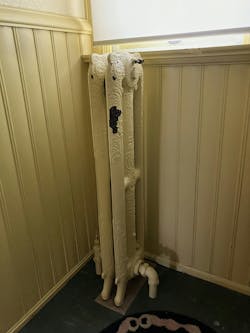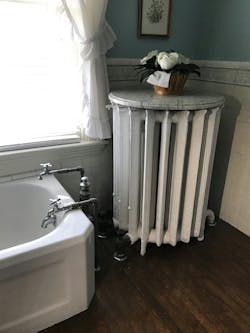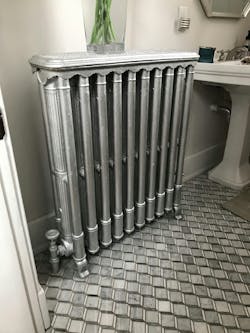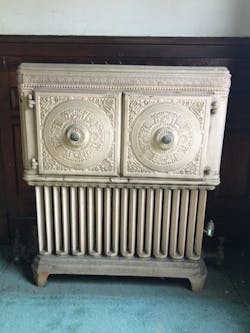Key Highlights
- Walk-around inspections are essential for accurately sizing and troubleshooting cast iron radiator systems
- Unique radiators, such as the two-section model and decorative round units, showcase the variety and craftsmanship of historic heating solutions
- Modern upgrades, like high-efficiency condensing boilers, work well with old cast iron systems due to their large water content and thermal mass
I’ve seen a lot of cast iron radiators during my 40 years-plus career of going to hot water and steam heating systems. Sometimes I’m there to size a new boiler. Sometimes I’m there to troubleshoot a system that’s not working. Sometimes it’s both—you never know walking in.
The Walk Around
To size a replacement boiler or troubleshoot a steam or hot water system with cast iron radiators, it always helps to walk through the building and find every radiator. With the proper measurements, the list can be used to estimate the radiation output.
When troubleshooting, the walk around will help determine type of system, type of trap or vents used, condition of radiator valves, size of piping at the radiator, I could go on and on. I would like to say I’ve seen it all, but every year I seem to find something different.
The Museum Piece
This year, I came across the only two-section radiator I’ve seen in my travels, as shown in photo #1. The rest of the cast iron radiators in this originally gravity-circulated hot water system had at least ten sections, in the always popular 38” high 3-column size. By far, that is the size I see the most.
But never as just the end sections. There’s no reason it can’t be done, just looked out of place being so tall and skinny in a half-bath on the first floor of a residence turned into a museum honoring a local world war two hero. The rest of the grand house has large radiators and a huge center staircase (complete with an imposing moose head).
The museum was looking for a replacement boiler, so I recommended a high efficiency modulating condensing hot water boiler. These old cast iron systems work quite well with the modern boiler, because the large water content causes a lot of condensate and the inherent mass works well with reset water temperatures.
My Old Kentucky Home
The radiator in photo #2 was also on a first-floor bathroom, but in an older home in the bourbon distilling region of Kentucky. The bathroom looked to be added on to the house when indoor plumbing was being introduced to the country. I had seen pictures of round radiators in old literature, but never in person.
Generally, the round radiator was shown wrapping around a column supporting the structure of the building. In this instance, they must have picked a round radiator for decorative purpose, covering the top with a beautiful marble slab. Imagine soaking in the tub on a cold winter day, looking out the window at snow covering the ground, and being warmed by that beautiful mass of cast iron.
Early Example
The radiator in photo #3 was also in a bathroom, but this time on the second floor. The cast iron top is removable. I used a similar style, but smaller, radiator as a podium during some of my steam training classes I gave in the early 2000’s.
What you can’t see too well in the photo is the other end of the radiator. It has a valve connected to the bottom of the radiator just like the one you see on the visible side. It also has an automatic air vent. This is a really early example of using steam to heat residences.
Steam came up through the supply valve from the steam main in the basement. It would naturally rise up to the top of the individual sections, condensing the steam as it warmed the cold steel. The steam would force the air from the supply side over to the automatic air vent on the return side, while the condensate would flow down the return line all the way to the wet return.
Each radiator was connected individually to the wet return to prevent steam from crossing over to the return side. The water level in the wet return, determined by the Hartford Loop, acted as the steam trap for each radiator. This required a lot more piping than other systems and eventually became obsolete.
A Bundy Classic
We had a working version of the dining room radiator at our sales counter for years, great for warming up your cold wet gloves on a frigid day. But this one was twice as ornate as that one, piped the same as the one in photo 3. In this photo you can’t see the supply and return piping, but you can see the automatic air vent.
The Bundy radiators were cast iron, but not sectional like we normally see. They had a cast iron base that the vertical cast iron columns were connected into. The base acted as a manifold to distribute steam and collect the condensate. They worked just fine, but also became obsolete pretty early on as sectional radiators were easier to assemble on site.
Medical Update
I went nervously to review my post-chemotherapy CT scan recently. I had to postpone the scan in order to have semi-emergency surgery on my left ankle, which I injured falling off my roof. (I know, old men aren’t supposed to go up ladders). My family and friends all told me this multiple times.
So, the surgeon comes in and wants to talk about the ankle, then finally realizes that he hasn’t given me the good news that my scan was clear. Needless to say, my wife and I were instantly relieved. Thanks to modern science, they were able to bring my body back to health. Now I have an ankle to rehab. It’s always something.
About the Author
Patrick Linhardt
Patrick Linhardt is a forty-one-year veteran of the wholesale side of the hydronic industry who has been designing and troubleshooting steam and hot water heating systems, pumps and controls on an almost daily basis. An educator and author, he is currently Hydronic Manager at the Corken Steel Products Co.




